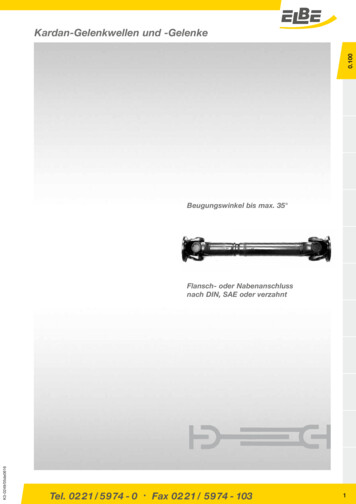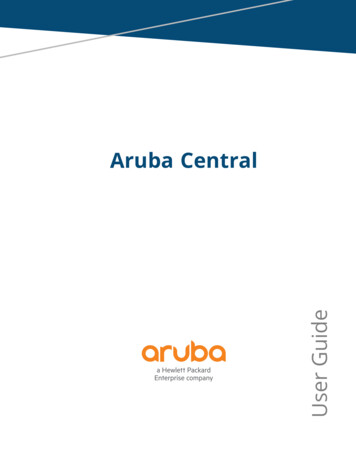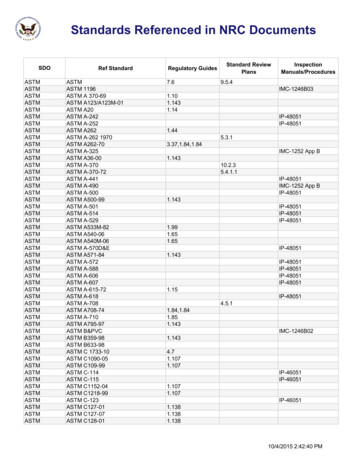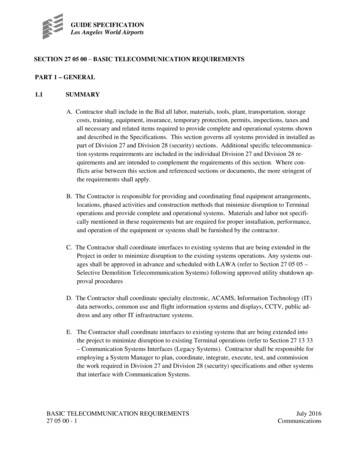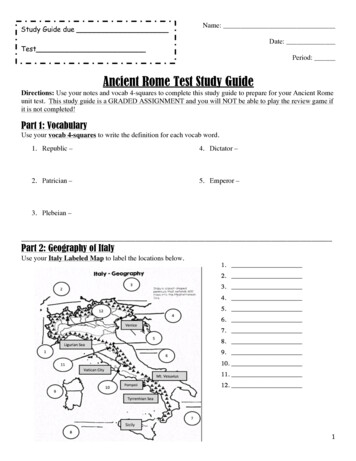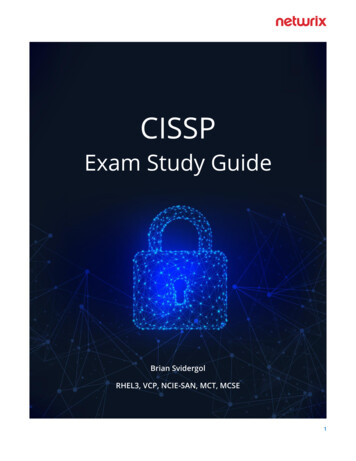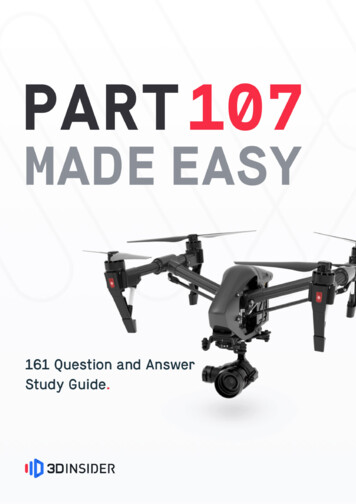
Transcription
1
INTRO DUCT I O NPurp os e o f th i s S t u d y G u i d eUnmanned Aerial Vehicles (UAVs), Small Unmanned Aerial Systems (sUAS) and “drones” areaircraft that have rapidly increased in popularity from being a hobby to a multimillion-dollarbusiness. Almost every news station has drone operators with cameras to capture all mannerof events and breaking news. Drones can also be used to inspect tall structures, aid in policeoperations, monitor events, survey property, advertise real estate, and much more. Basic UAVoperation is easy to learn, and many popular drone models are not terribly expensive, makingthis technology accessible to almost everyone.UAVs have inherent capabilities that were previously unavailable at such a huge scale and canbe perceived to be improper or illegal (i.e., “spying” on neighbors) or hazardous (flying overcrowds of people and stadiums). Moreover, just like any vehicle, drones can pose hazards topeople and property if not safely operated and maintained.As a result, the Federal Aviation Administration (FAA) has formulated rules that permit thecommercial use of UAVs in a manner that is safe and does not endanger people, property, andother aircraft while allowing the widest possible use of this technology. The FAA does notapply this regulation to hobbyists or hobby UAVs, provided they are operated in the spirit ofrecreational activities.The FAA views UAVs in commercial operations as “aircraft,” their operators as pilots, and theiroperation subject to FAA oversight and regulations just as they are responsible for mannedaircraft operations.UAV operators are regarded as “pilots” who are expected to understand the National AirspaceSystem (NAS) in which UAVs are operated, and certain rules and regulations are implemented toensure the safe operation of UAVs.The key to this safe operation is the pilot operating the UAV. This individual is operating anaircraft in US airspace and is expected to follow a set of rules similar to those that apply toany pilot. This requires not only the ability to fly and maneuver the UAV competently, but also acertain level of knowledge on factors that affect the operation of UAVs. These factors includethe different features of the NAS, safety, weather, coordination with local airports, air trafficcontrol, potential hazards, and occasional emergencies.As a result, the FAA promulgated the Small Unmanned Aircraft Regulations (sUAS) (Part 107of the Federal Aviation Regulations), similar to Parts 61 and 91 that are applicable to mannedaircraft.Note: We have created this guide to help you pass the Part 107 guide. We have spent hundredsof hours on this guide and we have tried to make it accurate. However, it's your responsibility tokeep up-to-date and verify the contents of this guide before flying your drone.2
TAB LE OF C O NT E N TSINTRODUCTION2CONTENTS3KNOWLEDGE TEST DESCRIPTION5LIST OF RESOURCES6GLOSSARY OF TERMS9CHAPTER 1:APPLICABLE REGULATIONS11CHAPTER 2:AIRSPACE CLASSIFICATION, OPERATING REQUIREMENTS, AND FLIGHTRESTRICTIONSCHAPTER 3:AVIATION WEATHER SOURCES58SECTION 3AMETEOROLOGICAL INFORMATION SOURCES AND UNDERSTANDING SUMMARY68CHAPTER 3B:EFFECTS OF WEATHER ON SMALL UNMANNED AIRCRAFT PERFORMANCESUMMARY79CHAPTER 4:SMALL UNMANNED AIRCRAFT LOADING80CHAPTER 5:EMERGENCY PROCEDURES83CHAPTER 6:CREW RESOURCE MANAGEMENT - DECISION -MAKING IN A DYNAMICENVIRONMENTCHAPTER 7:RADIO COMMUNICATION PROCEDURES3378590
CHAPTER 8:DETERMINING THE PERFORMANCE OF SMALL UNMANNED AIRCRAFT92CHAPTER 9:PHYSIOLOGICAL FACTORS AFFECTING PILOT PERFORMANCE93CHAPTER 10:MAINTENANCE AND PREFLIGHT INSPECTION PROCEDURES97APPENDIX 1REGISTRATION AND MARKINGREQUIREMENTS FOR SMALL UNMANNED AIRCRAFT102APPENDIX 2APPLICABLE REFERENCES102Pass the part 107test the easy wayOur readers can take advantage of an exclusive 50 offcoupon code to the professional Pilot Institute Part 107course. Save time and pass the test with ease.200 Easy to Follow Video Lectures2 Practice TestsGuaranteed You Pass or Your Test Fee is Freeget 50 off Part 107 course4
KNOWLE D G E T E ST D ES C R IP T IO NA key aspect of Part 107 for commercial UAV pilots is the requirement to demonstrate sufficient knowledge to operate a UAV safely and in accordance with applicable Federal AviationRegulations (FARs). To demonstrate the necessary knowledge, a UAV operator must either havea current pilot’s certificate (including a biennial review) or pass an FAA knowledge test to qualifyas a UAV Pilot-in-Command and obtain a Remote Pilot Certificate with a small Unmanned AircraftSystem (sUAS) rating.Note: the term “pilot” in this study guide refers to or includes operators of unmanned aircraftunless it is defined by a specific pilot role or rating such as “private” pilot or “airline” pilot.The certification knowledge test consists of objective, multiple-choice questions. There is asingle correct response for each test question. Each test question is independent of otherquestions. A correct response to one question does not depend upon, or influence, the correctresponse to another. The knowledge test applicant has up to two hours to complete the test.5
L IST OF R E S OU R C E SThis is a study guide, not a textbook. The information needed to successfully pass the FAA testfor the Remote Pilot Certificate is contained in the following documents:1.FAR Part 107 – In Effect since August 29, 2016 (or Latest Revision): This regulation defines the requirementsto become an sUAS certified pilot. It does NOT contain all of the information needed to pass the required test.https://www.faa.gov/uas/media/Part 107 Summary.pdfor electronic: https://www.ecfr.gov/cgi-bin/text-idx?SID.mc true&node pt14.2.107.2.Remote Pilot – Small Unmanned Aircraft Systems (Certification and Recurrent Knowledge Testing) - AirmanCertification Standards FAA-S-ACS-10A (June 2018 or most recent version)https://www.faa.gov/training testing/testing/acs/media/uas acs.pdf3.AC 107-2 - Small Unmanned Aircraft Systems (sUAS) – ory Circular/AC 107-2.pdf4.AC 60-22 - Aeronautical Decision Making – FAA https://www.faa.gov/regulations policies/advisory circulars/index.cfm/./226245.Aeronautical Information Manual (AIM) https://www.faa.gov/air traffic/publications/media/AIM Basicdtd 10-12-17.pdf6.Aeronautical Charts (Hardcopy): )http://faacharts.faa.gov/ or Aeronautical Charts (Digital): http://www.faa.gov/air traffic/flight info/aeronav/digital products/: (You will be required to demonstrate the ability to interpret symbols and information on Aeronautical Charts).7,Pilot/Controller Glossary: http://www.faa.gov/air traffic/publications/8.Pilot’s Handbook of Aeronautical Knowledge: http://www.faa.gov/regulations policies/handbooks manuals/aviation/ pilot handbook9.General Aviation Pilot’s Guide to Preflight Weather Planning, Weather Self-Briefings, and Weather DecisionMaking: www.faa.gov/nextgen/update/media/ga weather decision making.pdf.\10.Risk Management Handbook: http://www.faa.gov/regulations policies/handbooks manuals/aviation/media/faa-h- 8083-2.pdf.11.Airman Knowledge Testing (AKT) Centers: https://www.faa.gov/training testing/testing/media/test centers.pdfAll of these documents are available online free to download. You may, however, want topurchase copies of the Aeronautical Information Manual and copies of Sectional Charts for theareas in which you expect to operate an sUAS. Additional references may be cited in eachsection.6
Airma n K no w l ed g eTesting C e nt e r sThe FAA has authorized hundreds of airman knowledge testing center locations that offer afull range of airman knowledge tests. For information on authorized airman knowledge testingcenters and to register for the knowledge test, contact one of the providers listed on the AirmanKnowledge Testing Center List.Knowle d ge Te s t R eg i s t r at i o nWhen you contact an Airman Knowledge Testing Center to register for a test, be prepared toselect a test date, choose a testing center, and make financial arrangements for test payment.You may register for the test(s) several weeks in advance, and you may cancel in accordancewith the testing center’s cancellation policy. The fee for the test is 150.00.UAS To p ic sf or Kno w l e d ge Tes t i n gThe following table lists the general areas of required aeronautical knowledge, understanding,or proficiency required to obtain the small Unmanned Aircraft System (sUAS) rating.Area ofOperationITaskPercentage ofItems on TestA. GeneralB. Operating RulesC. Remote Pilot Certification with an sUAS rating30-40%D. WaiversIIA. Airspace ClassificationB. Airspace Operational RequirementsVB. Airport OperationsC. Emergency ProceduresD. Aeronautical Decision-MakingF. Maintenance and Inspection Procedures730-40%20-30%
The information in this study guide was arranged according to the knowledge areas that arecovered on the airman knowledge test for a Remote Pilot Certificate with a Small UnmannedAircraft Systems Rating as required by Title 14 of the Code of Federal Regulations (14 CFR) part107, section 107.73(a). The knowledge areas are as follows:1.Applicable regulations relating to small unmanned aircraft system rating privileges,limitations, and flight operation2.Airspace classification, operating requirements, and flight restrictions affecting smallunmanned aircraft3.Unmanned aircraft operations4.Aviation weather sources and effects of weather on small unmanned aircraft performance5.Small unmanned aircraft loading6.Emergency procedures7.Crew resource management8.Radio communication procedures9.Determining the performance of small unmanned aircraft10. Physiological effects of drugs and alcohol11. Aeronautical decision-making and judgment12. Airport operations13. Maintenance and preflight inspection procedures.8
Hold e rs o f P i l o t C er t i f i cat esissu e d und e r P ar t 6 1No Pilot Certificateor No Current Flight ReviewKnowledge Test Online ApplicationorPart 61 Pilot Certificatewith Current Flight ReviewOnline Course Online ApplicationKnowledge Test Online ApplicationKnowledge Test Paper ApplicationOnline Course OR Knowledge Test Paper ApplicationTo act as a remote pilot in command under Part 107, a person must have a remote pilotcertificate. However, part 61 pilot certificate holders who have completed a flight review withinthe past 24 months may elect to take an online training course focusing on UAS-specific areasof knowledge instead of the aeronautical knowledge test. The online training for current pilotcertificate holders is available at www.faasafety.gov (ALC-451: Part 107 Small Unmanned AircraftSystems). All other members of the public must take and pass the initial aeronautical knowledgetest to obtain a remote pilot certificate.G LOSSA RY OF TE R M SThe following terms are used throughout this document and can be considered equivalent andusually referring to a small unmanned aerial vehicle.1. “Drone” is a generic term applied, in this case, to any unmanned aircraft.2. Unmanned Aerial Vehicle (UAV) - UAVs may be either fixed-wing airplanes or rotary wingaircraft.3. Small Unmanned Aerial System (sUAS) – A UAV weighing 55 lb. or less. The term sUASrecognizes that most UAVs also include a control station, support equipment, and anoperator or even a team that make up the whole “system.”4. Unmanned Aircraft (UA)5. Remotely Piloted Vehicle (RPV)9
NOT ESSome sections of this study guide consist solely of example test questions, usually with briefexplanations of the answers. In some cases, brief sections of text are provided. However,users should read and study the text references relating to the subject and not rely solely onstudying the test questions.These questions were not taken from the official FAA tests. They are to assist and guide you instudying to prepare for the test. FAA tests will cover this same material, but the questions maybe worded differently. Therefore, you must learn and understand why each answer is correct.10
C HA P T ER 1:APPLICA BLE REGULATI O N SI NT ROD UCTIONFederal Aviation Regulations (FARs) cover almost every aspect of any flight operations. FAA testsare heavily weighted toward the applicant’s knowledge and understanding of FARs applicableto the type of operations the individual is applying for. FARs are organized by topics and eachmajor topic area is assigned a number. For example, FAR Part 91 covers general operating andflight rules for all pilots. FAR Part 61 covers the requirements for various levels of pilot certificates including student pilots, private pilots, commercial pilots, etc. FAR Part 107 is dedicated toregulations relating to the operation of the Small Unmanned Aerial Vehicles (sUAV)ST U DY R ESOUR CE SFAA sUAS Part 107: The Small UAS Rule – An overview of FAA Part 107This document briefly announces the publication of FAR Part 107.FA R P ar t 1 0 7In Effect since August 29, 2016 (or Latest Revision): This regulation defines the requirementsto become an sUAS certified pilot. It does NOT contain all of the information needed to pass therequired test. Applicants are advised to obtain a copy of FAR-107 and read and study it carefully(a total of 9 pages).Suggested study method: Read a section, e.g., “§107.3 Definitions,” and then look at the samplequestion(s). Text set off in “quotation marks” is text transcribed from the applicable FAA sourcedocuments.11
S ub p ar t A . G ener a l§107.3Definitions.The maximum allowable weight of a small unmanned aircraft system (sUAS) is:Question:The maximum allowable weight of a small unmanned aircraft system (sUAS) is:A. 0.55 lb.B. 55.0 lb.C. 100 lb.The correct answer is B. The sUAS can weight no more than 55 pounds, including all attached equipment andbatteries or fuel.Another definition of interest relates to a Visual Observer (VO).Question:A Visual Observer:A. Must also hold a remote pilot certificate.B. Must be in radio contact with the local Air Traffic Control agency.C. Must be in a position to assist the sUAS operator to see and avoid other air traffic.The correct answer is C. The VO should be in position to help the operator “see and avoid other air traffic or objectsaloft or on the ground.”§107.5Falsification, reproduction or alterationQuestion:A person who makes a duplicate copy of his remote pilot certificate and changes the name so that someoneelse can act as a sUAS pilot would be subject to:A. Suspension of revocation of his sUAS piloting privilegesB. Subject to a civil penaltyC. Both of the above.The correct answer is C. “No person may make or cause to be made any reproduction or alteration to anycertificate for fraudulent purposes. Suspension of certificate and civil penalties may apply.”12
§107.7Inspection, testing, and demonstration of complianceQuestion:The FAA has the authority to make any test or inspection of:A. The small unmanned aircraft.B. The remote pilot in command and the visual observerC. Both of the above.The correct answer is C. The FAA can test or inspect the unmanned aircraft, and/or any personnel involved in theoperation of that aircraft.§107.9Accident ReportingQuestion:When an sUAS is involved in an accident, when must a report be made to the FAA?A. Any accident must be reported to the FAA.B. An accident involving more than 500 damage to the UAV (unmanned aircraft) must be reported.C. An accident that involves loss of consciousness of any person must be reported.The correct answer is C: Any accident involving serious injury to any person or any loss of consciousness must bereported, and any accident that involves more than 500 damage to any property other than the sUAS.Question:When a sUAS is involved in a reportable accident, the report must be filed with the FAA within:A. 24 hoursB. 1 weekC. 10 daysThe correct answer is C.Su b p ar t A . Su m m a r ySubpart A focuses on what the FAA considers important aspects of at sUAS pilot. These are notoperational aspects of sUAS operations and must simply be learned or memorized. Note thatquestions will be worded to test you on fine distinctions—two or more answers will very similar,but with one single correct answer.13
S ub p ar t B. Op er a ting R u l e s§107.12Requirement for a remote pilot certificatewith a small UAS ratingThis section spells out the requirements under which an individual may operate an sUAS. The FAA uses aterm familiar to other pilots - “pilot in command” or PIC. By definition, the PIC is responsible for the safe operation of the aircraft and adherence to all FARs applicable to that operation. “Pilot in command” is a term andresponsibility that pilots and the FAA take seriously.Question:May an individual who does not hold a current remote pilot certificate operate the controls of a sUAS?A. No.B. Yes, if the pilot has 10 hours of instruction that is recorded in a logbook.C. Yes, when under the direct supervision of a Certified Remote Pilot in Command (PIC) who could takeimmediate control if necessary.The Correct Answer is C (see §107.12, (2)).§107.13RegistrationThis is one of those regulations that has already been written for other aircraft operations and Part 107 directs youto that regulation, in this case, FAR Part 91, §91.203(a)(2) that reads that an aircraft in the United States must beissued: An effective U.S. registration certificate issued to its owner for operation within the United States .Question:You plan to operate an unmanned aircraft as part of your photography business. The aircraft weighs approximatelythree pounds. With respect to registration:A. It does not need to be registered due to its light weightB. It must be registered, and the registration number must be on the aircraft.C. Only unmanned aircraft weighing more than 55 pounds must be registered.The correct answer is B: Unmanned aircraft operated under Part 107, which includes any commercial use of anaircraft, must be registered with the FAA, and the registration number should be displayed somewhere on theaircraft. The operator should have the aircraft’s registration certificate available when operating the aircraft. Thatis part of the inspection in §107.7.14
§107.15Condition for Safe OperationThis section refers to the condition of the aircraft,and simply requires that the aircraft must be in safe operating condition for flight. If it becomes unsafe for any reason, the flight is to be terminated. “Safe flight” means allinstalled equipment needed for safe operation and/or required by regulation for safe operation are in good workingcondition.Question:You are flying the aircraft 15 minutes after official sunset when you realize that the anti-collision light is not operating. You:A. Carefully scan the sky to ensure no other aircraft are operating in the vicinity, then continue to fly the mission.B. Immediately terminate the mission and recover the aircraft.C. Continue flying because you still have 15 minutes of civil twilight.The correct answer is B: Anti-collision lights are required for operation during the period of civil twilight whichbegins 30 minutes before sunrise or ends 30 minutes after sunset.Question:Ten minutes into a video flight, the camera stops functioning. You:A. Must terminate the flight because the camera is required for your mission.B. May continue the mission as a training exercise in aircraft control.C. May continue flying but must provide a report of the failure to the FAA.The correct answer is B: The camera is not essential equipment for the safe operation of the aircraft, so the aircraftcan continue to be flown. No report is necessary since this is not an emergency situation.Pass the part 107test the First TimeThe Part 107 test fee is 150. You won't get this money back if youdon't pass the test. Make sure you're fully-prepared before you goto the testing center. A Part 107 course is the perfect way to makesure you're ready on your first try.get 50 off Part 107 mote-pilot/15
§107.17Medical ConditionWhile there is no requirement for a medical certificate to operate an unmanned aircraft, pilots and other crewmembers are expected to be physically and mentally able to perform their duties. This includes not only the pilotin command, but anyone operating the aircraft controls and visual observers. (See AC 107-2 , Section 5.6, MedicalCondition)Question:As you prepare for a flight scheduled later in the morning, you realize that you do not feel well, and determine thatyou have a fever. Still, while you do not feel well, you decide you feel well enough to fly the mission.A. You should not fly the mission because you are not well.B. This is a judgement call and you will probably be okay.C. You will just stay in the truck and let the other pilot fly. He does not have his remote pilot certificate, but youhave trained him and decide he his competent to fly the mission.The correct answer is A. You are now a member of an elite group of individuals—pilots. Pilots do not fly when theyare not well. Even seemingly minor colds can create distractions during a flight, nor would you be considered wellenough to supervise a non-certified operator.§107.19Remote pilot in commandThis is the foundation of the term “pilot in command” (PIC). Basically, it means that the PIC is in command of theoperation and is responsible for the operation and safety of the UAV as well as people and structures within theoperating area. This includes making sure that any support personnel—another operator and/or a visual observerhave the knowledge and understanding to execute their responsibilities.Question:Who has the responsibility and final authority for the safe operation of a UAV?A. A competent but uncertified (unlicensed) pilot.B. The pilot in commandC. A visual observer closer to the aircraftThe correct answer is B: The PIC holds the ultimate responsibility for the safe and regulatory compliant operationof the UAV.Question:A UAV PIC is working with a visual observer (VO). The VO indicates that the aircraft should turn left to avoid anobstacle, but the VO is facing the pilot, and the pilot turns the aircraft to his left, not the observer’s left, and theaircraft strikes a building causing damage. Who is responsible?16
A. Neither since it was a simple accidental mistake.B. The VO for not realizing which direction to turn or using the wrong terminology.C. The Pilot in command for not clarifying the direction of the turn.The answer is C: Basically, the PIC is responsible for everything, even when a crew member makes an error.§107.21In-flight emergencyIn the event of an emergency, such as a fire on the aircraft or partial loss of control or power, the PIC is expectedto do whatever is possible/necessary to protect and avoid damage or injury to structures, equipment, or peopleon the ground. This may require deviating from one or more requirements that would be required during normal,non-emergency flight.Question:The PIC may deviate from any rule to the extent necessary to handle an emergency. Assuming the aircraft isrecovered from an emergency situation without damaging property or injuring any person, the PIC:A. Needs to do nothing.B. Should submit a report on the emergency only if requested by the Administrator of the FAA.C. Should submit a report on the emergency to the FAA.The correct answer is B: The PIC holds the ultimate responsibility for the safe and regulatory compliant operationof the UAV.§107.23Hazardous operationIt goes without saying—but just to make sure, the FAA says that “no person may operate an sUAS in a careless orreckless manner” that would endanger persons or property of another. This includes intentionally dropping objectsfrom the aircraft.Question:You have been asked to drop candy at a picnic. This is:A. Not permissibleB. Permissible if the candy pieces are equipped with little parachutes so as not to injure anyone.C. Permissible if the drop zone can be cleared of persons so there is no chance of injury.The correct answer is C: Dropping objects from the UAV is permissible provided precautions are taken to notdamage property or structures on the ground and to not provide a hazard to persons on the ground.17
§107.25Operation from a moving vehicle or aircraftOperating a UAV from an aircraft is prohibited. Operation of a UAV from a moving land or water-borne vehicle ispermitted only over sparsely populated areas and is not transporting another person’s property for hire.Question:Operating a UAV from a moving boat over a broad expanse of marsh is:A. Prohibited.B. Permitted.C. Permitted only when necessary to deliver cargo.The correct answer is B: The marsh would likely be a “sparsely populated area.”§107.27Alcohol or drugsThis regulation refers you to FARs §91.17 and §91.19. FAR §91.17 prohibits operation as a “crewmember” of anaircraft within 8 hours after the consumption of alcohol, or, while under the influence of alcohol, and under theinfluence of drugs. Having a blood alcohol level of 0.04 or greater is considered “under the influence.”Question:You attended a New Year’s Eve party, and your last drink was at 1:00 am on New Year’s Day. You planned accordingly,and are scheduled to fly your sUAS at 9:00 am, 8 hours later. You are:A. Absolutely legal to fly since it has been 8 hours since your last drink.B. May not be legal to fly if your blood alcohol level is still above 0.04.C. You have had several cups of coffee and are good to fly in any case.The correct answer is B. Blood alcohol levels do not necessarily drop below 0.04 in 8 hours, and you may still havea blood alcohol level that, if tested would result in operating under the influence of alcohol. This also applies to anyoperator of VO involved in the operation of the sUAS.This regulation also requires a crewmember to: (1) submit to a blood alcohol or related test when requested by anauthorized law enforcement officer, (2) submit blood alcohol test results to the FAA, and (3) the results of the testmay result in the person’s loss of qualifications for any airman certificate and other legal proceedings.18
§107.29Daylight OperationKey points of this part are (1) operation of a UAV during night time is prohibited, (2) operations during civil twilightrequires that the UAV be equipped with anti-collision lighting, and (3) “civil twilight” is defined.Question:The sun has just set, but visibility is still good during the twilight. As the pilot of an sUAS you:A. May operate your aircraft for up to 30 minutes after official sunsetB. May operate your aircraft for up to 30 minutes after sunset provided it is equippedwith an operating anti-collision light.C. May not operate the aircraft after official sunset.The correct answer is B. The anti-collision light is required during the period of civil twilight.Question:Your sUAS does not have an anti-collision light; how early in the morning may you begin to operate your sUAS.A. At sunrise.B. 30 minutes before official sunriseC. One hour before sunrise.The correct answer is A. An anti-collision light is required for operation during the period of civil twilight that begins30 minutes before official sunrise.Question:By definition, except for Alaska, morning civil twilight begins:A. 30 minutes before official sunrise.B. At a time determined by reference to the Air AlmanacC. 30 minutes after sunrise.The correct answer is A. Civil twilight, except for Alaska, is defined as the period beginning 30 minutes beforeofficial sunrise and ending 30 minutes after official sunset.19
§107.31Visual line of sight aircraft operationIt is reasonable to expect that the operator of a sUAS should be able to see the aircraft throughout its flight, butthis regulation makes it official. It also recognizes that a visual observer may be needed at times when the aircraftwould otherwise be out of sight of the operator.Question:The operator of an unmanned aircraft must be able to maintain visual contact of the aircraft:A. With unaided eyesight (except corrective lenses).B. With the use of handheld binoculars.C. Except brief periods when the aircraft’s view is blocked by obstructions.The correct answer is A: The operator is required to be able to see the aircraft at all times if a visual observer is notavailable. Corrective lenses are permitted.Question:The operator of an unmanned aircraft:A. Must maintain eye contact with the UAV at all times.B. Must be able to maintain contact with the UAV at all times but may briefly divert his vision to lookfor other aircraft, obstructions, or the controls as needed.C. Must have a VO to be permitted to break eye contact with the UAV.The correct answer is B: You may, and are expected to, briefly scan the area around the UAV to ensure continuedsafe operations. However, you must be able to maintain visual contact. Do not allow it to fly out of sight where youwould not be able to see it without the aid of a VO.Question:You are flying your sUAS over a small wildfire adjacent to a small community airport. A column of smoke rises up andobscures your view of the aircraft you:A. Must reverse course immediately to regain visual contact with the aircraft.B. Must regain sight of the aircraft within 90 seconds or activate auto return or auto land.C. Since the circumstances of each flight vary, it is the PIC’s responsibility to determine how long to wait beforemaking the decision to recall the aircraft, hover, or land the aircraft.The correct answer is C. Reference AC 107, VLOS Aircraft Operation.20
§107.33Visual ObserverWhen the mission may require periods when the aircraft will not be visible to the pilot in command or operator ofthe aircraft, a visual observer (VO) may be used. The VO should be in a position to maintain visual contact with theaircraft when it is not visible to the operator. More than one VO may be used.Question:You are planning an unmanned flight for a client. Circumstances require that the aircraft pass behind a billboardsign to reach the desired vantage point. You know that you can direct the aircraft to maintain direction and altitude until it becomes visible on
Note: the term “pilot” in this study guide refers to or includes operators of unmanned aircraft unless it is defined by a specific pilot role or rating such as “private” pilot or “airline” pilot. The certification knowledge test consists of objective, multiple-choice questions. T
